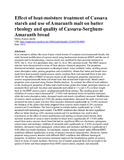| dc.description.abstract | In an attempt to address the issue of poor crumb texture of sorghum-cassavaamaranth breads, this study focused modification of cassava starch using heatmoisture treatment (HMT) and the use of amaranth malt in breadmaking. Cassava starch was modified by heat-moisture treatment at 80ᄚC for 8, 16 or 24 h incubation time, and 18, 24 or 30% moisture levels. The HMT cassava starches were characterized in terms of their physico-chemical properties.
The properties determined included; measurements on damaged starch, water solubility index, swelling power, water absorption index, pasting properties and crystallinity. Gluten-free batter and breads were made from heat-moisture treated cassava starch, sorghum flour and amaranth flour in the ratio 50:40:10. The effect of HMT of cassava starch on the rheological properties and texture of cassava-sorghumamaranth batter and bread were then determined respectively.
Bread crumb properties were measured using Texture Profile Analysis. To evaluate the effect of malt addition on the rheological properties of batter and crumb texture gluten-free bread, proximate analysis on amaranth flour and malt was done arid amaranth malt added at 1 % and 2.5% on flour weight basis to the HMT cassava starch- sorghumamaranth flour mixture.
The swelling power and solubility of cassava starch decreased (P ::5 0.05) with increased levels of moisture treatment, while the water absorption index, damaged starch and starch crystallinity increased. Modification of cassava starch increased (p:5 0.05) the pasting temperature. decreased the peak viscosity and increased the time to peak viscosity. Heat-moisture treatment significantly (p :5 0.05) increased the firmness of the gluten-free batter prepared from cassava starch treated at 24% moisture content and 8 h incubation.
The force required to extrude batters significantly (p :5 0.05) increased with increasing malt content. The HMT condition that showed the most significant effect on batter rheology (24% moisture content and 8 h incubation) was used to draw conclusions on the effect of starch modification and malting on bread crumb texture. Heat moisture treatment of cassava starch resulted in bread with a significantly (P :5 0.05) softer crumb than native cassava starch bread but had no significant effect on chewiness, springiness. cohesiveness and resilience.
Addition of amaranth malt significantly (p :5 0.05) increased crumb hardness, decreased crumb springiness. cohesiveness and resilience and had no significant (p:5 0.05) effect on crumb chewiness. In conclusion. cassava starches treated under different HMT conditions differed significantly in terms of physico-chemical characteristics. Moreover, batters prepared using cassava starches with different HMT conditions had different rheological properties. In addition. heat moisture treatment improved the breadmaking quality of cassava starch in terms of crumb hardness.
However, use of malted amaranth flour did not improve the quality of batter and bread prepared from HMT cassava starch, sorghum and amaranth. Obtaining a uniform product by HMT was quite a challenge in this study, due to partial gelatinization of starch. Therefore, it would be recommended that other treatment combinations, including a varied temperature range should be used to obtain bread with improved textural properties. | en_US |

